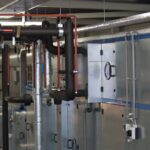Building Thermally Stable, GMP-Compliant, and Adaptable Pharma Infrastructure
Cleanroom construction in pharmaceutical facilities demands precision, durability, and regulatory compliance. Traditionally, civil construction with epoxy finishes or modular drywall systems dominated the industry. Today, PUF (polyurethane foam) panels are rapidly replacing legacy models, offering modularity, better insulation, and faster deployment.
Advantages of PUF Panels Over Conventional Construction
- Superior thermal insulation (R-values) improving HVAC efficiency
- Factory-fabricated panels reduce on-site contamination and variability
- Easy installation and maintenance through tongue-and-groove assembly
- Resistance to microbial growth and chemical agents
Performance Benefits
- Closed-cell insulation minimizes moisture absorption
- Low particle shedding supports ISO Class 5–8 environments
- Supports positive pressure maintenance in Grade A/B areas
- Available with fire-retardant and anti-static coatings
Compliance and Structural Integrity
- Tested to ASTM and EN standards for structural load and fire resistance
- Smooth, non-porous surfaces for easy cleaning and validation
- Non-toxic materials meeting FDA/WHO/ISPE cleanroom guidelines
- Seamless integration with flush doors, windows, covings, and pass boxes
Use Cases
- Cleanroom partitions and walls
- Modular cold rooms and isolator enclosures
- Controlled environments for R&D and pilot plants
PUF panels provide a cost-effective, GMP-aligned infrastructure solution for new builds, expansions, or retrofits. With lower maintenance needs and faster installation, they are ideal for pharma environments that demand rapid scalability and uncompromised compliance.





